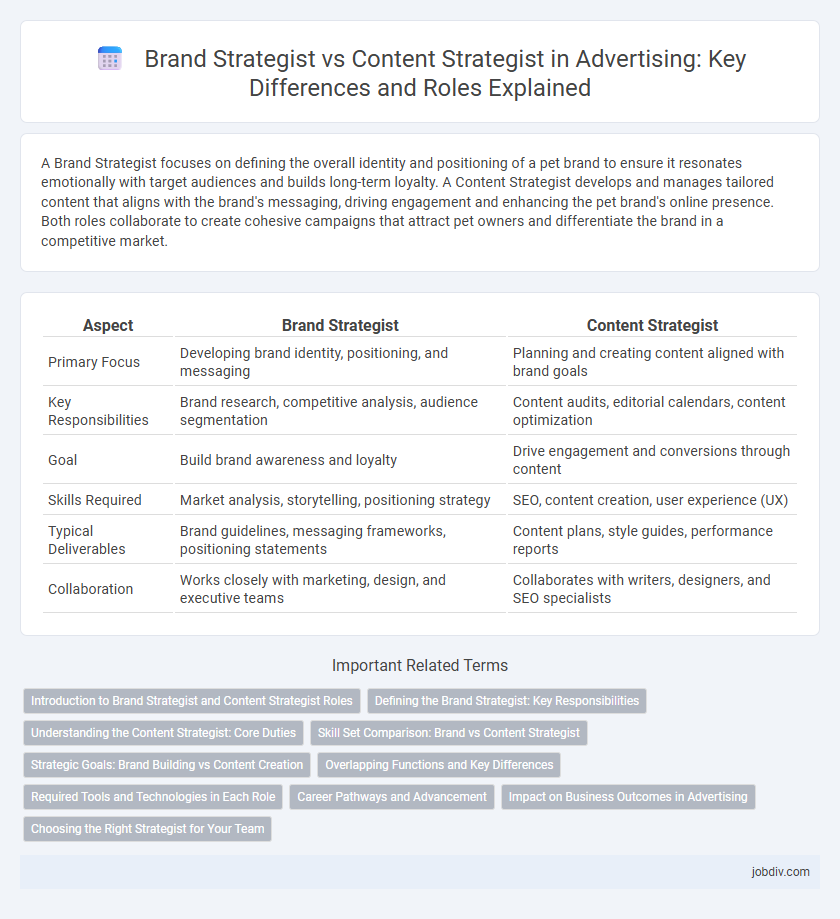A Brand Strategist focuses on defining the overall identity and positioning of a pet brand to ensure it resonates emotionally with target audiences and builds long-term loyalty. A Content Strategist develops and manages tailored content that aligns with the brand's messaging, driving engagement and enhancing the pet brand's online presence. Both roles collaborate to create cohesive campaigns that attract pet owners and differentiate the brand in a competitive market.
Table of Comparison
| Aspect | Brand Strategist | Content Strategist |
|---|---|---|
| Primary Focus | Developing brand identity, positioning, and messaging | Planning and creating content aligned with brand goals |
| Key Responsibilities | Brand research, competitive analysis, audience segmentation | Content audits, editorial calendars, content optimization |
| Goal | Build brand awareness and loyalty | Drive engagement and conversions through content |
| Skills Required | Market analysis, storytelling, positioning strategy | SEO, content creation, user experience (UX) |
| Typical Deliverables | Brand guidelines, messaging frameworks, positioning statements | Content plans, style guides, performance reports |
| Collaboration | Works closely with marketing, design, and executive teams | Collaborates with writers, designers, and SEO specialists |
Introduction to Brand Strategist and Content Strategist Roles
Brand Strategists develop comprehensive strategies to define and position a brand's identity, ensuring consistent messaging across all marketing channels. Content Strategists focus on planning, creating, and managing content tailored to engage target audiences and support brand objectives. Both roles collaborate to align brand messaging with effective content delivery, optimizing consumer connection and brand loyalty.
Defining the Brand Strategist: Key Responsibilities
Brand strategists focus on defining the core identity, values, and positioning of a brand to ensure consistency across all marketing efforts. Their key responsibilities include conducting market research, analyzing consumer insights, and developing long-term brand plans that align with business objectives. They collaborate closely with creative teams and stakeholders to maintain brand integrity and drive overall brand equity.
Understanding the Content Strategist: Core Duties
Content strategists develop comprehensive plans to create, deliver, and manage valuable content aligned with brand goals. They conduct audience research, create editorial calendars, and ensure consistency across channels to drive engagement and conversion. Their role integrates SEO practices, content governance, and performance analytics to optimize content effectiveness.
Skill Set Comparison: Brand vs Content Strategist
Brand Strategists excel in market research, brand positioning, and consumer behavior analysis, leveraging skills in storytelling and visual identity to build long-term brand equity. Content Strategists specialize in content creation workflows, SEO optimization, and audience engagement analytics, focusing on delivering targeted messages across digital platforms. Both roles require strong communication and project management skills, yet Brand Strategists emphasize brand consistency and perception, while Content Strategists prioritize content relevance and performance metrics.
Strategic Goals: Brand Building vs Content Creation
Brand Strategists prioritize long-term brand equity, aiming to develop a cohesive identity and emotional connection with the audience through consistent messaging and positioning. Content Strategists focus on creating targeted, audience-specific content that drives engagement, conversions, and supports marketing campaigns. While brand building fosters loyalty and recognition, content creation delivers immediate value and measurable interaction across channels.
Overlapping Functions and Key Differences
Brand strategists and content strategists both focus on creating cohesive messaging that aligns with business goals and audience needs, optimizing brand identity and storytelling to enhance engagement. Brand strategists primarily concentrate on defining the overall brand vision, positioning, and long-term reputation, while content strategists develop targeted content plans, distribution tactics, and editorial guidelines to support specific marketing campaigns. The overlap exists in their shared goal of ensuring consistent brand voice, yet they differ in scope, with brand strategists shaping brand perception and content strategists managing content creation and user experience.
Required Tools and Technologies in Each Role
Brand Strategists primarily utilize data analytics platforms like Google Analytics and consumer insight tools such as Nielsen to identify market trends and shape brand positioning. Content Strategists rely heavily on content management systems (CMS) like WordPress, editorial calendars, and SEO tools including SEMrush or Ahrefs to plan, produce, and optimize digital content. Both roles increasingly incorporate collaboration software such as Slack and project management tools like Asana to streamline workflow and communication.
Career Pathways and Advancement
Brand Strategists focus on shaping a company's identity and market positioning, leveraging consumer insights and competitive analysis to drive long-term growth. Content Strategists specialize in planning, creating, and managing content to engage target audiences and support marketing goals. Career advancement for Brand Strategists often leads to roles in marketing leadership or executive brand management, while Content Strategists typically progress into roles like content director or digital marketing manager.
Impact on Business Outcomes in Advertising
Brand Strategists drive business growth by aligning brand identity with market positioning, ensuring consistent messaging that enhances customer loyalty and market share. Content Strategists impact advertising outcomes by creating targeted, engaging content that boosts audience engagement, lead generation, and conversion rates. Together, they optimize advertising effectiveness through cohesive brand narratives and strategic content distribution, directly influencing revenue and return on investment.
Choosing the Right Strategist for Your Team
Selecting the right strategist for your advertising team hinges on distinct goals: a Brand Strategist crafts overarching brand identity and market positioning to build long-term equity, while a Content Strategist develops targeted messaging and content plans to drive engagement and conversions. Companies aiming to strengthen brand perception and competitive differentiation benefit from a Brand Strategist's insights, whereas those focused on content marketing effectiveness and audience interaction rely on a Content Strategist's expertise. Evaluating your team's needs for brand coherence versus content execution ensures optimal strategic alignment and campaign success.
Brand Strategist vs Content Strategist Infographic

 jobdiv.com
jobdiv.com